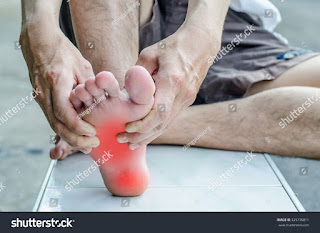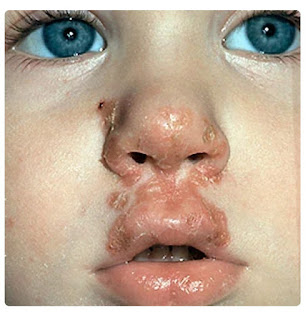DIABETIC FOOT CARE
Written by Timothy Okooboh
Diabetes mellitus is one of the leading causes of non-traumatic lower extremity amputation (LEA) worldwide. Prevalence rates of diabetic foot lesions vary from 0.9 - 8.3 % in Nigeria.
Diabetes is a disease in which blood glucose levels are elevated either as a result of insulin deficiency or impaired sensitivity of insulin receptors. Insulin is the hormone that promotes the absorption of glucose into the liver, fat and skeletal mucles. Therefore, problems with insulin secretion or impaired response to insulin production will lead to the build up of glucose in the blood, known as hyperglycemia.
Complications due to diabetes can be classified into two groups: macrovascular and microvascular complications. Macrovascular complications due to diabetes include coronary artery disease, peripheral arterial disease and stroke. Microvascular complications due to diabetes include diabetic neuropathy, diabetic retinopathy and diabetic nephropathy.
Peripheral arterial disease (a macrovascular complication) and diabetic neuropathy (a microvascular complication) are the two major causes of diabetic foot problems. Spontaneous blisters and visual impairment (which can predispose individuals to foot injuries because of poor eye sight) are also risk factors for diabetic foot problems such as foot ulcers.
Important Statistics
• It is estimated that every 30 seconds a lower limb is amputated somewhere in the world due to diabetes.
• 10 % of people with diabetes have a foot ulcer and the life time risk of developing a foot ulcer for someone with diabetes is 25 %.
• Approximately 20 % of hospital admissions for people with diabetes are due to foot ulcers.
• Peripheral arterial disease and diabetic neuropathy are involved in approximately 45 % of diabetic foot ulcers.
• Up to 50 % of diabetic foot ulcer cases can be prevented by appropriately educating diabetic patients on how to care for their feet.
Diabetic Foot Problems
Foot ulcers, corns, calluses, hammertoes, bunions and fungal infections of the feet, are common problems experienced by diabetic patients. These problems are not peculiar to diabetics but the risk is higher in diabetics because of peripheral arterial disease, diabetic neuropathy and visual impairment.
Peripheral arterial disease reduces blood flow to the feet. As a result, it takes longer for a cut or wound in the feet to heal. Diabetic neuropathy causes damage to the nerves of the feet. Although diabetic neuropathy makes the feet hurt, it also reduces sensation to pain, heat and cold hence, small cuts on the feet may go unnoticed and gradually worsen into an ulcer after infected.
•Foot Ulcers
Foot ulcers are inflammatory and suppurating lesions on the feet. Hyperglycemia, peripheral arterial disease and diabetic neuropathy can make cuts or injuries to the feet take longer to heal. This increases the risk of being infected and developing into a foot ulcer or gangrene (death of tissues due to lack of blood). It is therefore very important for foot injuries experienced by diabetic patients to be treated urgently and properly especially by podiatrists. Severe foot ulcers may require amputation. It is estimated that every 30 seconds a lower limb is amputated somewhere in the world due to diabetes. A research published on the 16th of March 2013 in the Nigerian Medical Journal revealed that of 61 diabetic patients with diabetic foot ulcers, only one patient acknowledged receiving any form of foot care and foot wear education. 45.9 % of patients with diabetic foot ulcers presented to hospital with Wagner grade iv and v ulcers with the resultant need of some form of amputation. The amputation rate was 52.5 % because 8.9 % of patients refused surgery.
•Corns and Calluses
A corn is a build up of hard skin near a bony area of a toe or between toes. Corns may develop as a result of pressure from shoes that rub against the toes or cause friction between the toes.
• Hammertoes
A hammertoe is a toe that is bent because of a weakened muscle. It can also be caused by shoes that are too short.
Foot care tips for diabetic patients
Diabetic patients should be educated about the following tips for caring for their feet. This can help to prevent diabetes-induced foot complications discussed above. These tips can be provided by pharmacists as they are the most accessible health care givers and diabetic patients visit the pharmacy regularly to obtain their medications and self-diagnostic tools.
• Inspect feet daily.
The feet should be inspected daily for cuts or blisters. Due to diabetic neuropathy, small cuts and bruises on the feet may go unnoticed. Diabetic patients should therefore inspect their feet on a daily basis and if any injury is found, medical attention should be sought immediately.
• Never walk barefoot
As much as possible diabetic patients should avoid walking barefoot. Even at home shoes or slippers should be worn.
• Keep the feet clean always by washing gently with a soft sponge.
• Never use hot water on the feet. Lukewarm water should be used in bathing the feet.
• Wear properly fitted shoes and avoid socks with seams which could rub and cause blisters.
• Shake out shoes and feel the inside before wearing as there may be some sharp objects or pebbles in the shoes.
• Wear appropriate athletic shoes when exercising. Exercise helps to increase blood flow in the feet.
• Moisturize your feet to prevent cracking and itching due to dry skin. But don't moisturize between the toes as it could encourage a fungal infection.
• Never treat corns and calluses your self. Seek medical attention.
• Adhere to your medications, life style modifications and don't miss appointments with your doctor. These are to properly control blood glucose levels and prevent hyperglycemia.
• See a podiatrist at least once in a year. Podiatrists are health care professionals who specialize in the care of foot problems.
Just like hypoglycemia education, diabetic foot care education should be included as part of educational tips provided to diabetic patients. Diabetic foot ulcers and other diabetes-induced foot problems are highly preventable if proper education on foot care is provided to the patients. Availability of podiatrists is rare in developing countries therefore, prevention through proper education is the key.










Enter your comment...Nice and educative.
ReplyDeleteThanks for sharing with me.
Interesting read. Thanks
ReplyDeleteNice piece
ReplyDeleteReally nice, Sir. Starting the day learning something as cool as this ,thanks.
ReplyDeleteNice sir...learnt sth great today
ReplyDeleteBeautiful piece
ReplyDeleteThis is a very beautiful piece... thanks
ReplyDeleteOmg! This is really painful. Get rid of them easily at home with KidSole products for corn treatment, like foam cushions or severs socks. With the best quality products, https://kidsole.com/ helps you to find the correct insole for your child for an astonishing fit.
ReplyDeleteNice article. Ensure you always wear diabetic shoes for men and ladies.
ReplyDeleteThanks for sharing this post. For diabetic foot diabetic dress socks are very useful.
ReplyDeleteI found your this post while searching for some related information on blog search...Its a good post. Keep posting and update the information. Best Heart Supplements, Anti Aging Supplement
ReplyDeleteEdema slippers are best to get relief from diabetic feet. People who are suffering from this problem can use this shoes.
ReplyDeleteThese days you can take plenty of educational courses online, and the area of podiatrist marketing is no exception. You can learn all about feet and ankles in the comfort of your own home, at a time of day or night that works well with your other commitments. There are several different Podiatry courses you can choose to enroll in for the online curriculum.
ReplyDelete